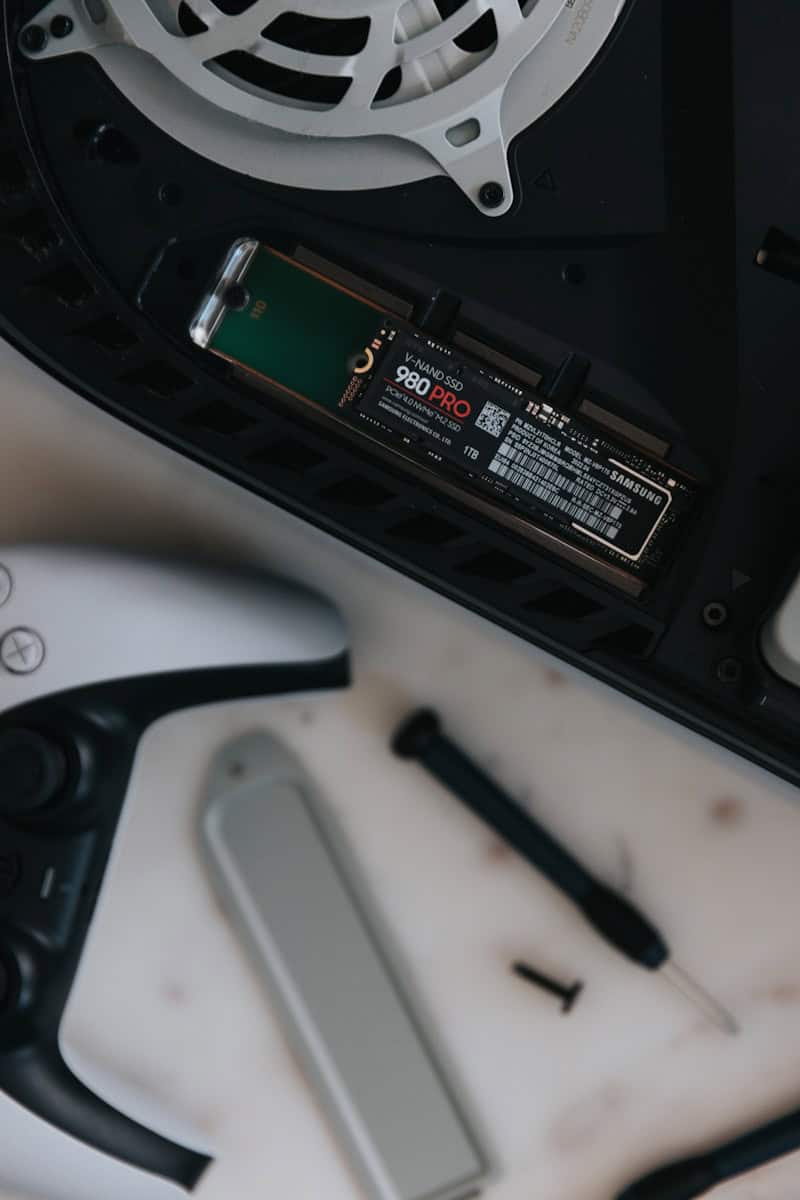If you play lots of games on your PlayStation 5, you might find that you run out of storage space. This guide will look at different ways to add more storage to your PS5. You can use the console’s own storage, add an M.2 SSD, or connect an external USB drive. Each option has its own requirements, benefits, and limits. As game files get larger, the PS5’s built-in storage might not be enough for everyone.
It’s important to add more storage so you can keep all your games and apps organized and easy to access. You have a few options for adding storage to your PS5. Expand your PS5 gaming library and experience faster load times with a high-speed M.2 SSD. Upgrading your storage is a game-changer, and we’re here to help you choose the perfect M.2 SSD for your PS5. The easiest way is to use an external USB drive to store and manage your games and apps.

You can also install an M.2 SSD, which will give you faster speeds and more storage. Making sure it’s compatible and following the installation guidelines will help everything go smoothly. Having better storage options can improve your gaming experience if you like to have many games on hand. Using external drives, M.2 SSDs, and cloud storage options can give you the flexibility you need and make your games and apps easier to access, getting the most out of your PS5.
Expanding Your PS5 Storage Options
Built-in Storage
The PlayStation 5 comes with a custom 825GB solid-state drive (SSD). However, the usable storage is less due to system files and the operating system.
M.2 SSD Expansion Slot
A dedicated M.2 slot allows users to install a compatible SSD to significantly increase storage.
| Requirements for M.2 SSDs | Description |
|---|---|
| Interface | PCIe Gen4 x4 NVMe SSD |
| Storage Capacity | 250GB – 4TB |
| Sequential Read Speed | 5,500MB/s or faster |
| Form Factor | M.2 2230, 2242, 2260, 2280, 22110 |
| Socket Type | M.2 Socket 3 (Key M) |
| Heatsink | Required, either included with the SSD or installed separately (not exceeding the slot dimensions) |
External USB Storage
While not as fast as the internal SSD or an M.2 SSD, external USB drives offer an affordable way to expand storage.
| Requirements for USB Drives | Description |
|---|---|
| Interface | SuperSpeed USB 5Gbps or later |
| Storage Capacity | 250GB minimum, 8TB maximum |
| Additional Notes | Not all USB drives are guaranteed to work with the PS5. |
Managing Storage
PS5 offers various options for managing storage:
- Moving Games: Transfer games between internal, M.2 SSD, and USB storage.
- Deleting Games: Remove unwanted games to free up space.
- Re-Downloading Games: Downloaded games can be re-downloaded from your library.
- Checking Storage Usage: View detailed storage information in the system settings.
Key Takeaways
- Expanding storage is necessary for game and app management.
- External USB drives and M.2 SSDs are practical storage solutions.
- Checking compatibility and guidelines ensures a smooth upgrade.
Understanding PS5 Storage
Managing PS5 storage is crucial given the size of modern games. This guide covers different storage options, compatibility, installation, and data management.
Types of PS5 Storage Solutions
Internal Storage: The PS5 comes with an 825GB SSD built-in. This provides fast load times and excellent performance.
External Storage: You can connect an external hard drive or SSD via USB. This option allows you to store older games (PS4) or media files.
M.2 SSD: An M.2 SSD can be installed internally to increase storage capacity. This type of storage is necessary for playing PS5 games directly from it.
Official Storage Expansion Options
Sony-Approved M.2 SSDs: The safest method for expanding storage is using a Sony-approved M.2 SSD. These SSDs meet specific requirements to ensure compatibility and performance.
USB Extended Storage: For additional storage without opening the console, use an external USB 3.0 drive. This is suitable for media and older game storage but doesn’t support playing PS5 games.
PlayStation Cloud Storage: PlayStation Plus members can use cloud storage to save game data. This helps reduce the burden on local storage.
Compatibility and Requirements
Internal SSD Requirements: Any internal M.2 SSD must be PCI-Express Gen4x4 and support the NVMe interface. The form factor should be 2230, 2242, 2260, 2280, or 22110. A heatsink is also recommended for better cooling.
External Drive Compatibility: External drives should be at least 250GB and not larger than 8TB. They must be FAT32 or exFAT formatted.
Performance Needs: An M.2 SSD should have a sequential read speed of at least 5,500MB/s for PS5 games to run smoothly.
Step-by-Step Installation Guide
- Power off the PS5 and remove all cables.
- Place the PS5 on a flat surface and remove the side panels.
- Use a Phillips screwdriver to remove the metal cover over the SSD slot.
- Insert the M.2 SSD into the slot at an angle and push it down until it clicks.
- Secure the SSD with the provided screw and spacer.
- Reattach the metal cover and side panels.
- Reconnect the PS5 and power it on.
- Format the new SSD by following the on-screen prompts.
Managing PS5 System Storage
Settings: Go to Settings, then Storage. You can view and manage your data here.
Move & Copy Data: To free up space, move or copy games and apps to external storage. Select the item, then choose Move to USB Extended Storage.
Erase Data: Deleting games or apps you no longer use is essential. Select the item and click Delete to remove it from your console.
Backup: Regularly backing up your important data to an external drive or the cloud can prevent potential loss.
By understanding these storage solutions and processes, you can effectively manage and expand your PS5’s storage capacity.
Boost Your PS5 Storage with these Top M.2 SSD Picks
Key Considerations
- Compatibility: Ensure the SSD meets Sony’s requirements: PCIe Gen4, M.2 form factor, minimum 5,500 MB/s read speed, and a heatsink.
- Capacity: Choose a capacity that suits your needs and budget. 1TB is the minimum, but 2TB or 4TB offer more space for games.
- Performance: While most PCIe Gen4 SSDs will offer a significant boost over the internal PS5 storage, consider a high-performance drive for the fastest load times and game transfers.
- Heatsink: Some SSDs come with a pre-installed heatsink, while others require you to purchase one separately. Make sure the heatsink fits within the PS5’s size restrictions.
Recommended M.2 SSDs for PS5
| SSD | Capacity Options | Read Speed (MB/s) | Heatsink Included? | Notes |
|---|---|---|---|---|
| WD_Black SN850X | 1TB, 2TB, 4TB | Up to 7,300 | Optional | Top overall pick for performance and reliability |
| Samsung 990 PRO | 1TB, 2TB, 4TB | Up to 7,450 | Yes (with and without RGB) | Excellent performance, single-sided 4TB option |
| Seagate FireCuda 530 | 500GB, 1TB, 2TB, 4TB | Up to 7,300 | Yes | Solid performance and comes with a heatsink |
| Corsair MP600 PRO LPX | 500GB, 1TB, 2TB, 4TB | Up to 7,100 | Yes | Designed specifically for PS5, low-profile heatsink |
| Crucial P5 Plus | 500GB, 1TB, 2TB | Up to 6,600 | Yes | Good value, heatsink included |
| Sabrent Rocket 4 Plus | 1TB, 2TB, 4TB | Up to 7,000 | No | Great performance, but requires a separate heatsink |
| Gigabyte AORUS Gen4 7000s | 1TB, 2TB | Up to 7,000 | Yes | High performance with a sleek heatsink design |
| Inland Performance Plus | 1TB, 2TB | Up to 6,600 | No | Budget-friendly option, but requires a separate heatsink |
Additional Tips
- Installation: Installing an M.2 SSD in your PS5 is a straightforward process, but make sure to follow Sony’s official instructions carefully.
- Firmware Updates: Keep your SSD’s firmware up to date to ensure optimal performance and compatibility.
- Game Transfers: Transferring games between the internal and M.2 SSDs is easy within the PS5’s settings menu.
- External Storage: While M.2 SSDs offer the best performance, you can also use external USB drives for storing PS4 games and media files.
Frequently Asked Questions
Expanding the storage on a PS5 can improve your gaming experience, but there are key details you need to know. Below, you will find answers to the most common questions about PS5 storage.
What are the specifications for expanding storage on the PS5?
The PS5 allows for the use of M.2 SSDs to expand its storage. These SSDs must have a PCIe Gen 4 x4 interface and at least 5,500MB/s read speed. The SSD must also fit within the physical size parameters set by Sony.
How can I install a new SSD into my PS5?
First, turn off and unplug your PS5. Remove the console cover, then locate the SSD bay. Insert the M.2 SSD and secure it with the screw provided. Replace the cover and plug in the console. Turn on your PS5 and format the new SSD through the settings menu.
What are the differences between internal and external storage options for the PS5?
Internal storage refers to the built-in and expandable SSD within the PS5, offering faster load times and better performance. External storage, such as USB drives, can store PS4 games and other data but cannot run PS5 games directly from it.
Are there any proprietary requirements for PS5 storage drives?
Yes, the PS5 requires that any expansion SSD must meet specific speed and size requirements. The drive must have a read speed of at least 5,500MB/s and fit into the M.2 slot with dimensions defined by Sony.
What is the process to format an external drive for use with the PS5?
Plug the external drive into one of the PS5’s USB ports. Go to Settings, then Storage, and select the drive. Choose “Format as Extended Storage.” Follow the on-screen instructions. The drive is now ready to store games and data.
How does the addition of an SSD affect the performance of the PS5?
Adding an SSD can significantly improve load times and overall game performance by offering quicker data access. This means faster game launches and smoother gameplay, enhancing your overall experience.







